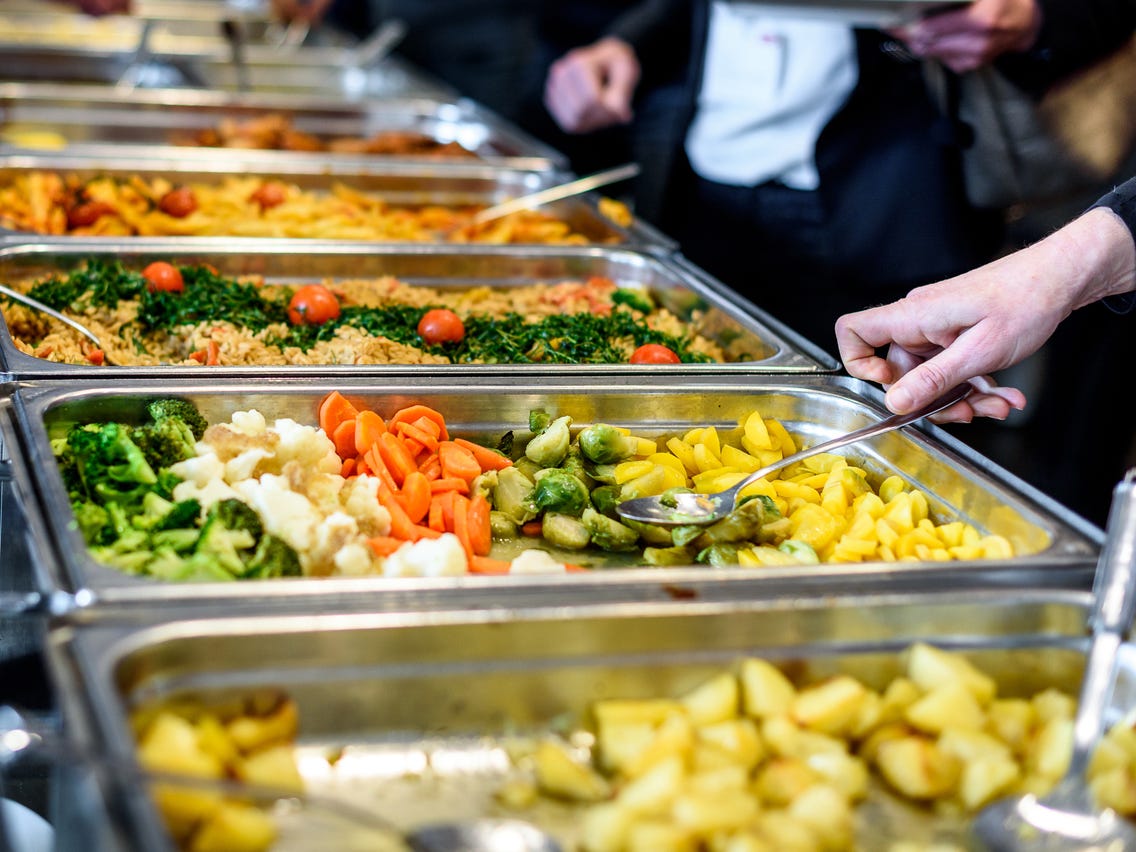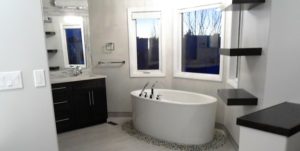
The Pros of Buffets
Deciding on the kind of catering that will suit your event is absolutely important, so let’s go through the positives and negatives of buffet style catering and other options. Whilst buffets are a popular choice for organisers as they appear a much better value and more flexible option, it’s important to comprehend different types of buffets and their purpose, to choose if they benefit a particular event.
Buffet style catering can indicate having food stations set up on long tables where guests can view the different offerings and usually help themselves. Foods are usually finger foods, hot or cold, made to be eaten standing with perhaps a small plate and/or napkin. This is usually considered the most casual design of meal service and offers a much less formal gathering ideal for post sports occasions, perhaps for a younger crowd and events over a shorter timescale like a funeral reception or tea party where the guests can mingle and network.
However, a buffet can likewise have servers stationed behind the buffet tables serving different dishes to the guests. Based on the sort of event this can be as simple or as theatrical and dazzling as required, with whether simple “one for all” dish or a more extravagant buffet menu. Popular nowadays is to have a number of different world food styles such as a sushi bar, street food, Thai and Mexican as examples. The theatre is provided with the chefs the ability to carve meats at the buffet table and/or describe the intricacies of every dish. This really is a great option for events with a pan-global or pan-cultural guest list, and occasions having to impress.
The Pros: Fewer servers are needed with a straightforward buffet reception in comparison with a formal sit back meal, which means you may save money on your catering staff charges although you still need staff to have a tendency to the buffet, and waiters to provide water and wine to the tables. Buffets make it easier and less expensive to provide guests with a variety of choices, helpful since people have so many types of allergies and dietary restrictions nowadays. This service style also promotes mingling and interacting among guests. By shelling out for staff serving and monitoring portion sizes you can save considerable monies on not having to provide extra portions plus the staff can attend to the presentation on an ongoing basis therefore the next group/table feel their visit to the buffet is really as special as the first group.
The appeal of the buffet is pretty obvious. They offer guests an opportunity to sample new and ground breaking items and to choose those which tempt their palate; most guests benefit from the adventure of discovering new delicacies and never have to purchase an entire portion.
Buffets add excitement by offering creative salads and appetizers, hot and cold dishes prepared at interactive stations and succulent desserts.
For the operator, buffets are as appealing. Generally, the labor cost is a lot lower since all dishes are prepared ahead of the time in bulk. The actual service period can be managed with fewer employees than an a la carte or plated banquet scenario. Furthermore, more guests can be catered in specific time period, enabling the operator to carefully turn tables often.
On the other hand, a buffet is merely profitable if it sells well; ample leftovers can diminish the profit.
Pricing and portion control
Determining the food cost is one of the challenges of the buffet. It is very difficult to predict how much each guest will consume. In long term buffets it may also be difficult to forecast the volume of guests for a meal period.
To calculate the price for a buffet, the price tag on each item on the menu should be verified, especially new dishes. Established items which may have proved to be cost effective should be reviewed periodically. The total cost for the buffet is added up after all of the items have been considered. This is the estimated pre-cost of the buffet. This amount, however, assumes that every guest will have only one portion of each item. Reality oftentimes looks different; don’t assume all guest takes one portion of each item. Therefore, the total pre-cost figure is merely a guideline helping to determine the purchase price. It still needs to be verified at the end of the buffet.
The portion sizes on buffets should be not even half how big is a la carte portions. Large portions increase waste, and high-cost entrees are consumed in greater amounts. Giving guests the possibility to taste small portions of each item will cause them to become try the less expensive dishes.
A subtle food-cost control measure is to pre-plate more costly items. Not only does it help to reduce waste and over production; it also offers a touch of elegance. On the other hand, pre-plating can drastically improve the labor cost; to ensure quality, well-qualified staff must arrange nice looking plates. An oftentimes overlooked aspect of portion control on a buffet is the size of serving utensils. Time and again, large kitchen spoons and ladles find their way to the buffet line, leading to significant waste. Designated serving utensils donate to the correct portion control.
Food served on smaller trays and platters may need to be replaced more frequently, but it does convey the message that you can find no endless supply and will guide the guest to take just a few selections rather than over-fill their plates. Serving food in smaller serving vessels also provides the ability to get more variety.
Controlling costs
Controlling buffet costs isn’t easy. Implementation and follow through of strict rules is crucial. Using this method, costing becomes better to overview and less intimidating, allowing the operator to establish a good profit margin.
Holding a higher-ranking employee accountable for each and every step of the production and service will help keep costs in line. Clear and simple directions to the employees, written rather than verbal, are crucial to avoiding miscommunication, which can result in over- or underproduction. Maintaining accurate and up-to-date logs of the day-to-day operation helps to make decisions whether to retain or reject a certain dish based on its profitability. Food cost is not the only factor; labor costs for preparation as well for service, showmanship and equipment costs play an important role in the pricing of any buffet as well.
The equipment
Equipment must be capable of keeping food safe and at the right temperature. Equipment also serves to highlight the foodstuff. Real marble is a perfect display base for cold foods, helping to maintain a cold temperature while being appealing to the eye. Oftentimes unconventional serving vessels are used to provide food. Sushi can be presented on oversized bamboo mats. Southeast Asian stews and curries put in a tropical feel to the buffet when they are presented on banana leaves. The theme of the buffet often determines the gear and serving vessels. Chinese food can be quite appealing if presented in decorative woks or clay pots. Classical French food advantages from being displayed on traditional silver platters.
Where food temperature is concerned the trend is toward integrated burners and heat-plates to carry food in attractive dishes. For simple catering situations, however, chafing dishes still come in handy. To hold cold food, integrated refrigeration is the ideal solution; if not available, insulated crocks, bowls and hotel pans work, some featuring double walls with a refrigerant gel. Frozen overnight, they hold a temperature of less than 40°F for as much as eight hours.
The beauty of a buffet is quickly damaged after the guests start assembling their plate. To counter this, consider using smaller trays, perhaps with separators. Change trays frequently so they look fresh and attractive. To break the monotony, use trays and plates in a number of shapes, sizes and colors. Decorative risers and colorful table clothes reflecting the theme, the occasion or the function put a third dimension to the buffet. Attractive enhancements such as sculptures created from ice, butter or chocolate beautify it.
Interactive stations, where dishes are prepared to order, require special equipment. If there are no integrated burners in the station, lightweight gas burners can be used. The better choice is induction cook-tops. Since there is no flame, there’s little potential for injury. They heat up fast, cool off quickly and are affordable and energy efficient
So if you’ve been looking up Golden Corral menu prices today, here are some things you ought to know about this restaurant chain. Below are the latest Golden Corral prices. (DINE-IN MENU)
| ITEM | PRICE |
|---|---|
Adults |
|
Breakfast |
|
| Saturday & Sunday (Open – 11 A.M.) | $10.49/person |
Lunch |
|
| Monday thru Saturday (Open – 4 P.M.) – Beverage Not Included | $10.29/person |
Adult Dinner |
|
Beverage Not Included |
|
| Monday thru Thursday (4 P.M. – Close) | $14.99/person |
| Friday & Saturday after 4 P.M. | $14.99/person |
| Sunday after 11 A.M. | $14.99/person |
Children
|
|
Includes Beverage |
|
| 3 & Under (Free) | $0.00/child |
| Ages 4-8 | $6.99/child |
| Ages 9-12 | $7.99/child |
Dinner |
|
| 3 & Under (Free) | $0.00/child |
| Ages 4-8 | $7.99/child |
| Ages 9-12 | $8.99/child |
Seniors |
|
Breakfast |
|
| Saturday & Sunday (Open to 11 A.M.) – Ages 60 & Over. | $9.99/person |
Lunch |
|
| Monday thru Saturday (Open – 4 P.M.) – Ages 60 & Over, Does Not Include Beverage | $9.79/person |
Senior Dinner |
|
Beverage Not Included |
|
| Monday thru Thursday (4 P.M. – Close) | $13.99/person |
| Friday & Saturday after 4 P.M. | $13.99//person |
| Sunday after 11 A.M. | $13.99//person |
| Senior Early Bird Special (Mon. thru Fri. from 11 A.M. to 3 P.M.) – Includes Beverage | $8.99/person |
To Go |
|
| Breakfast | $6.99/pound |
| Lunch (Monday thru Friday) | $6.49/pound |
| Dinner (Monday thru Friday & all day Saturday & Sunday) | $8.49/pound |
Food safety
One of the main aspects of any buffet is food safety, a constant challenge for the foodservice industry. It really is paramount to be familiar with and comply with new and changing sanitation regulations. Implementing and enforcing a rigorous cleaning and sanitation schedule verified with up-to-date logs is an excellent beginning. Ideally, all foodservice employees are certified in food safety to encourage personal responsibility.
The temperature danger zone, between 41°F and 141°F, is another very important factor of food safety. Within this temperature range, pathogens can multiply rapidly and spoil most items high in moisture and low in acidity. Keeping the meals out of this range is essential; as per food safety authorities, top of the limit of exposure time at temperatures between 41° and 141° is four hours.
Hot food for buffets is often kept hot for extended periods; the temperature should be checked and documented by an employee member frequently. An infrared thermometer is a convenient tool for that, but it only measures surface temperature. To verify internal temperatures of whole roasts and the like, you desire a probe thermometer.
Glass shields, installed above the food, are a good way to keep food safe, especially from accidental sneezing.
By controlling the actions of everybody mixed up in buffet preparation and presentation, you can minimize risks and ensure optimum safety. The responsibility of foodservice operators is to supply the guest with a great meal and a unique experience as well as to ensure the well-being of the client.

